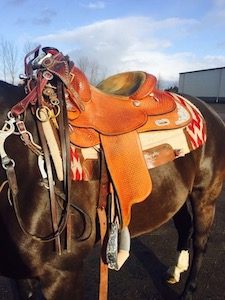Saddle Pad Care
by Theresa Rice

When you first tried your saddle on your horse, I’m sure you also evaluated the fit of the saddle pad. Acting as a shock absorber and a tool for improving saddle fit, the saddle pad plays an important role in your horse’s comfort.
Horse owners are encouraged to re-evaluate saddle fit as their horse grows, gains a more muscular topline, or loses weight. As the shape of the horse’s back changes, the saddle you use might need to change as well. But what about that thing under the saddle? When is the last time you’ve given much thought to the condition of your saddle pad?
It can be easy to take the condition of our tack for granted and assume all is well if there are no complaints in the form of bad behavior from our horses. But there are things to look for in your saddle pad before your horse’s behavior makes a turn for the worse.
If you use a felt pad, put one hand on either side of the pad (the side that sits on the back and the saddle side). Run your hands down the length of the pad feeling for thin spots. You can also evaluate for packed-down areas by putting the pad on a hard floor and walking on the pad in bare feet. With a fleece pad (wool or synthetic) you are trying to identify the same thing—any areas that have been compressed and variations in thickness.
The age and the quality of your pad will impact how long the saddle pad lasts. A weekend warrior will keep a pad in shape longer than someone riding for hours every day. The most common area for pad compression is where the bars of the saddle sit. Over time, those areas can become packed down. Uneven thickness can translate to uneven weight distribution of the rider and saddle. The packed down areas can also inhibit free movement of the horse, as the pad should act as a buffer against friction between the rigidity of the saddle and the dynamic movement of the horse’s back.
Uneven weight distribution can lead to discomfort for the horse and the previously mentioned bad behavior. We want the horse to be comfortable, and we really want to avoid horses behaving badly. Horses behaving badly can lead to riders performing unplanned dismounts.
If your pad has a consistent thickness throughout but looks dirty or crusty in spots, you can wash the pad. For felt or fleece pads, lay the pad flat and power wash the underside. A word of caution here: do not get the power washer head too close to the pad or you might drill a hole right through the pad. Once clean, leave the pad out in the sun to dry.
Some people might recommend washing the pad with soap. I am not one of those people, as soap’s purpose is to break down and wash away oils. We want to wash away dirt, sweat buildup (salt deposits) and stuck-on hair, so there is no real reason to wash with soap. If you do use soap, make sure to thoroughly rinse the pad until all suds are washed away, as the soap residue can be an irritant.
One last word of caution on maintaining your saddle pads: if you have a horse with any type of infection (fungal, rain rot) do not share pads from infected horses with healthy horses, as this can transfer the infection. Spray any affected pads with a disinfectant and let the pad thoroughly dry out. You can also set pads in the sun, as the UV rays will help kill off fungus.
Best of luck in keeping your pads in ultra-plush shape for as long as possible.
Originally Published June 2017 Issue

Theresa grew up riding horses off and on throughout her life, finally fulfilling her dream of horse ownership in 2012. She is currently working on her first novel, inspired by her time spent working on a guest ranch in Arizona where she met her husband. They married in 2012. When not writing, you can find her riding her half-Arabian gelding, Gangster, or chasing after her two German Shepherds. website: www.sassinboots.com








